A look at per-worker personal income, what’s left of it after inflation.
By Wolf Richter for WOLF STREET.
Adjusted for inflation, consumers’ personal income from all sources – from wages, interest, dividends, rental income, unemployment compensation, stimulus checks, Social Security benefits, etc. – so “real” personal income dipped by 0.2% in October from September to a seasonally adjusted annual rate of $17.7 trillion, up by only 0.8% from a year ago, according to the Bureau of Economic Analysis.
Personal income last year and earlier this year gyrated wildly and was grotesquely inflated by the various stimulus payments and special unemployment benefits. Most of the pandemic-specials have now expired:
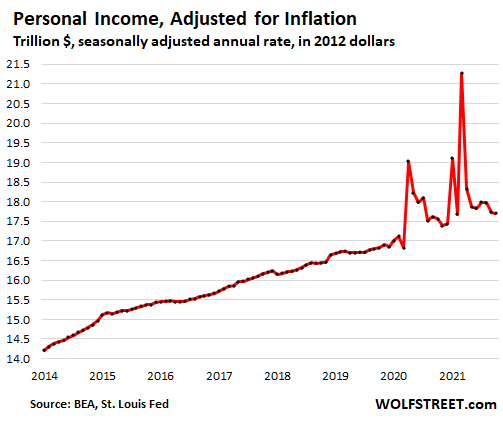
Personal income without stimulus and transfer payments, after inflation – so this is personal income from labor, interest, dividends, rental property, etc. but without transfer payments from the government, such as unemployment benefits, stimulus payments, Social Security benefits, welfare benefits, etc. – was flat for the month, at a seasonally adjusted annual rate of $14.3 trillion.
And it has gone nowhere over the past five months, with all nominal income gains getting eaten up by inflation.
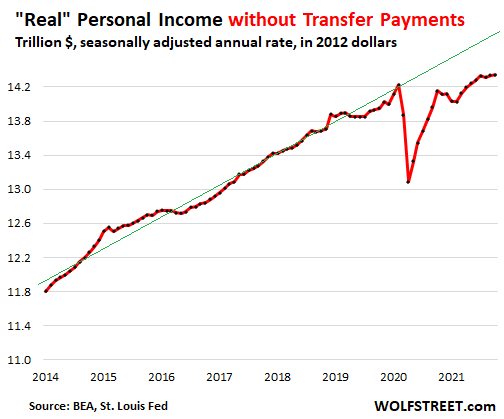
But wait… More people working, each making less after inflation
This “real” (inflation adjusted) income without transfer payments is a function of two factors:
- Amount earned by each consumer
- Number of consumers who are earning money.
Real income without transfer payments has been flat for the five months through October. But in October, 2.4 million more people worked than five months earlier.
In other words, the number of workers making money with their labor grew from 151.6 million workers in June to 154.0 million workers in October, and yet all workers combined made the same amount of money adjusted for inflation over those five months. Meaning, on a personal level, on average each worker lost ground to inflation.
For the past five months, inflation as measured by the BEA has eaten up any and all income gains from promotions and hiring bonuses and higher wages paid to attract workers, and hire wages to retain workers, etc., plus some.
This chart shows the seasonally adjusted annual rate of “real” income without transfer payments, divided by the number of workers (Bureau of Labor Statistics household survey which I discuss here).
Bringing more people back to work increased overall income before inflation; inflation then ate all the gains in aggregate; and then on a personal level, more workers divided up the same “real” income pie, and each is getting a smaller slice.
The spike last spring was caused by 22 million workers losing their job, and income without transfer payments also plunged (as shown in the 2nd chart above), but was divided by 22 million fewer workers, and some of furloughed workers continued earning money, while income from rents, dividends, interest, farming interests, etc. continued flowing. And it also shows that this metric is returning to pre-pandemic trends:
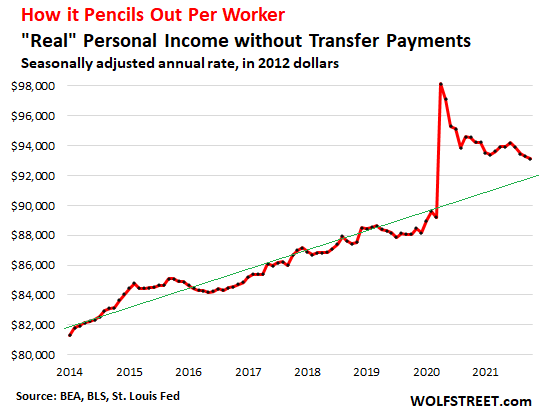
This phenomenon of how individual workers are getting shafted by inflation – despite the rise in nominal wages – also shows up in the broader metric released by the BEA: the Per-Capita “Real” Disposable Income, which takes total income from all sources, including transfer payments, minus income-related taxes, adjusted for inflation, and divided by the US population (not number of workers).
In October, it dropped to the lowest level since November last year, and has now dropped below the pre-pandemic trend:
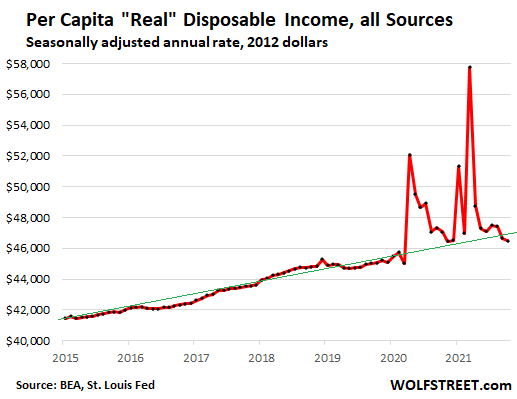
Less real income, No Problem: Consumers spent heroically.
Even adjusted for inflation, consumer spending in October rose by 0.7% from September, and by 6.6% from a year ago, to a record seasonally adjusted annual rate of $13.9 trillion.
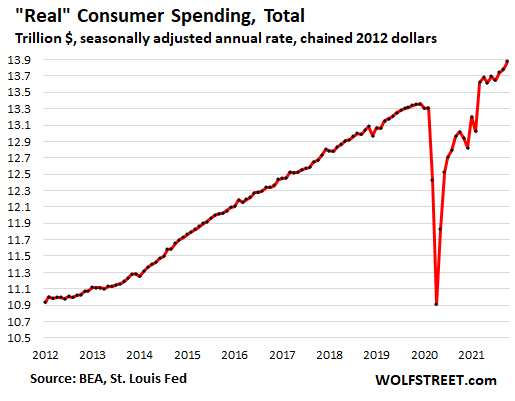
October was the first month of Q4 GDP. Consumer spending is about two-thirds of GDP. In terms of GDP, what matters is aggregate spending, not income. And spending was strong, even after inflation.
For the months, and after inflation, spending on all three major categories picked up: Durable goods (+2.0%), Non-durable goods (+0.4%), and services (+0.5%). The green line shows the pre-pandemic trend:
These are huge amounts that people spent, and they’re still flush with money from the pandemic-specials, and many have used those funds to pay down their credit cards, so now they have more room to borrow. And other people have used those funds to get caught up on their late payments and their credit score went up, and they have an easier time to borrow new money. And people are still spending the $800 billion in forgivable and by now largely forgiven PPP loans that went to just about everyone. And people are borrowing against their stock market gains and crypto gains and they’re spending this money – and they’re spending it regardless of what prices are.
Enjoy reading WOLF STREET and want to support it? Using ad blockers – I totally get why – but want to support the site? You can donate. I appreciate it immensely. Click on the beer and iced-tea mug to find out how:
Would you like to be notified via email when WOLF STREET publishes a new article? Sign up here.
![]()
Classic Metal Roofing Systems, our sponsor, manufactures beautiful metal shingles:
- A variety of resin-based finishes & colors
- Deep grooves for a high-end natural look
- Maintenance free – will not rust, crack, or rot
- Resists streaking and staining
To reach the Classic Metal Roofing folks, click here or call 1-800-543-8938
Read More:Each Worker’s Slice of After-Inflation-Income Pie Is Shrinking. But No Problem, They Spend Heroically
2021-11-25 22:14:40

